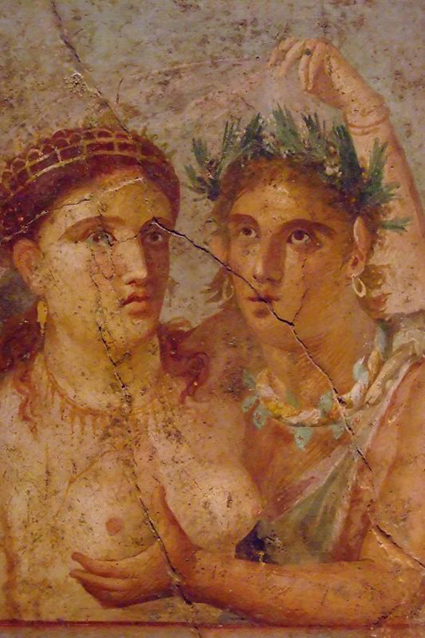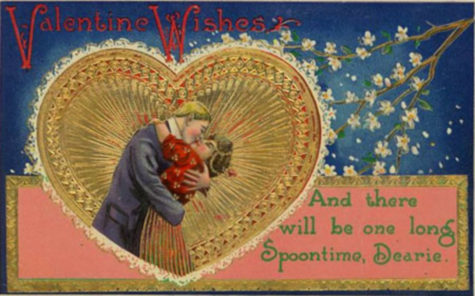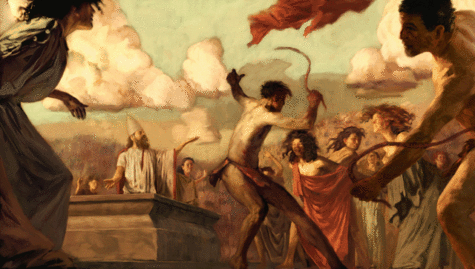Daily Archives: February 14, 2016
Valentine’s Day has its roots in ancient orgiastic festivals. On February 14, The Romans celebrated Febris (meaning fever), a sacred sexual frenzy in honor of Juno Februa, an aspect of the goddess of amorous love. This sex fest coincided with the time when the birds in Italy were thought to mate.
The ecstatic rites of the Goddess merged over time with those of Lupercalia, the bawdy festivities in honor of the pagan god of sex, drugs and rock-n-roll, Pan, which were observed on the following day, February 15.
On Lupercalia, (named, incidentally, in honor of the she-wolf who suckled Romulus and Remus), men and women inscribed their names on love notes or billets and then drew lots to determine who their sex partner would be during this anything goes festival of erotic games.
Sulpicia, a first century BC Roman poet, describes her participation in the events with hearty candor:
“At last love has come. I would be more ashamed
to hide it in cloth than leave it naked.
I prayed to the Muse and won. Venus dropped him
in my arms, doing for me what she
had promised. Let my joy be told, let those
who have none tell it in a story.
Personally, I would never send off words
in sealed tablets for none to read.
I delight in sinning and hate to compose a mask
for gossip. We met. We are both worthy.”
Roman armies took their Lupercalia customs with them as they invaded France and Britain. One of these was the above mentioned lottery where the names of available maidens were placed in a box and drawn out by the young men. Each man accepted the girl whose name he drew as his love – for the duration of the festival, or sometimes longer.
Lupercalia, with its lover lottery, had no place in the new Christian order. In the year 496 AD, Pope Gelasius did away with the festival of Lupercalia, citing that it was pagan and immoral. He chose Valentine as the patron saint of lovers, who would be honored at the new festival on the fourteenth of every February. The church decided to come up with its own lottery and so the feast of St. Valentine featured a lottery of Saints. One would pull the name of a saint out of a box, and for the following year, study and attempt to emulate that saint.
The Feast of St. Valentine and the saint lottery lasted for a couple hundred years, but the church just couldn’t rid the people’s memory of Lupercalia. In time, the church gave up on Valentine all together. The lottery finally returned to coupling eligible singles in the 15th century. The church attempted to revive the saint lottery once again in the 16th century, but it never caught on.
During the medieval days of chivalry, the single’s lottery was very popular. The names of English maidens and bachelors were put into a box and drawn out in pairs. The couple exchanged gifts and the girl became the man’s valentine for a year. He wore her name on his sleeve and it was his bounded duty to attend and protect her. The ancient custom of drawing names on the 14th of February was considered a good omen for love.
By the early 1600s, handmade valentines were customarily sent from admirers to sweethearts. About 1800 the first commercial cards appeared. Cards were usually sent anonymously. As early as 1822, an English official reported having to hire extra postal workers on this day. In 1849, Esther Howland of Worcester, Massachusetts, started selling quality valentines so popular that she was called “Mother of the American Valentine.”
Sources:
Lupercalia is uniquely Roman, but even the Romans of the first century were at a loss to explain exactly which deity or deities were being exalted. It hearkens back to the days when Rome was nothing more than a few shepherds living on a hill known as Palantine and was surrounded by wilderness teeming with wolves.
Lupercus, protector of flocks against wolves, is a likely candidate; the word lupus is Latin for wolf, or perhaps Faunus, the god of agriculture and shepherds. Others suggest it was Rumina, the goddess whose temple stood near the fig tree under which the she-wolf suckled Romulus and Remus. There is no question about Lupercalia’s importance. Records indicate that Mark Antony was master of the Luperci College of Priests. He chose the Lupercalia festival of the year 44BC as the proper time to offer the crown to Julius Caesar.
February occurred later on the ancient Roman calendar than it does today so Lupercalia was held in the spring and regarded as a festival of purification and fertility. Each year on February 15, the Luperci priests gathered on Palantine Hill at the cave of Lupercal. Vestal virgins brought sacred cakes made from the first ears of last year’s grain harvest to the fig tree. Two naked young men (called Lupercii) asisted by the Vestals, sacrificed a dog and a goat at the site. The blood was smeared on the foreheads of the young men and then wiped away with wool dipped in milk.
The Lupercii them skinned the sacrificed goat and ripped the hide into strips which they tied around their naked waists and led groups of priests around the pomarium, the sacred boundary of the ancient city, and around the base of the hills of Rome. The occasion was happy and festive.
They then got drunk, and ran around Rome striking everyone they met with strips of the goat hide. This act supposedly provided purification from curses, bad luck, and infertility. Young women who were touched in this manner were thought to be specially blessed, especially in regards to fertility and procreation.
It is from these implements of purification, or februa, that the month of February gets its name.
Long after Palentine Hill became the seat of the powerful city, state and empire of Rome, the Lupercalia festival lived on. Roman armies took the Lupercalia customs with them as they invaded France and Britain. One of these was a lottery where the names of available maidens were placed in a box and drawn out by the young men. Each man accepted the girl whose name he drew as his love – for the duration of the festival, or sometimes longer.
Lupercalia, with its lover lottery, had no place in the new Christian order. In the year 496 AD, Pope Gelasius did away with the festival of Lupercalia, citing that it was pagan and immoral. He chose Valentine as the patron saint of lovers, who would be honored at the new festival on the fourteenth of every February. The church decided to come up with its own lottery and so the feast of St. Valentine featured a lottery of Saints. One would pull the name of a saint out of a box, and for the following year, study and attempt to emulate that saint.
If you are interested, you can read more about Valentine’s Day (and how it came to be what it is today) on it’s own separate page.
A modern approach to the Lupercalia is as follows:
- Themes: Love; Passion; Romance; Sexuality
- Symbols: Doves; Flowers; Berries; Trees; Pine Cones
- Presiding Goddess: Venus
About Venus:
Venus was originally an Italic goddess of blossoms; hearts and flowers have slowly become attributed to her loving, passionate energies. In fact, her name became the root for the word venerate – to lift up, worship, or esteem. So it is that Venus greets pre-spring efforts for uplifting our hearts with positive relationships.
To Do Today:
During Lupercalia, an ancient predecessor of Valentine’s Day, single girls put their names in a box, and unmarried men drew lots to see with whom they would be paired off for the coming year. To the more modern minded, try pinning five bay leaves to your pillow instead to dream of future loves. If you’re married or otherwise involved, steep the bay leaves in water and drink the resulting tea to strengthen the love in your relationship.
To encourage balance in a relationship, bind together Venus’s symbols, a pine cone and a flower, and put them somewhere in your home. Or, to spice up a passionate moment, feed fresh berries to each other and drink a berry beverage from one cup (symbolizing united goals and destinies).
In Roman tradition, anywhere there’s a large stone adjacent to a tall tree, Venus is also there. Should you know of such a place, go there today and commune with her warm lusty energy.
Sources:







